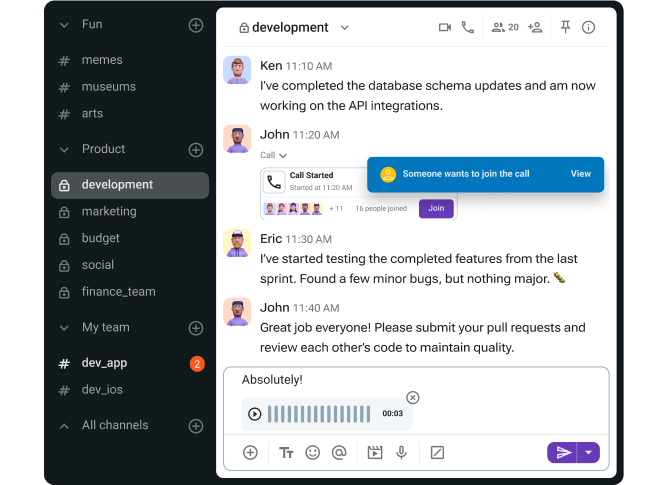Al analizar la comunicación en un entorno formal y buscar maneras de mejorarla, generalmente se requiere concentración y comprensión para evaluar la situación correctamente.
Aquí es donde entran en juego los modelos de comunicación transaccional.
Los modelos transaccionales de comunicación nos permiten comprender el proceso comunicativo desde diferentes perspectivas y evaluar la comunicación con mucha más precisión que con los modelos tradicionales.
En este artículo:
- Explicaremos los modelos transaccionales de comunicación,
- Describiremos en qué se diferencian de otros modelos de comunicación, y
- Ofreceremos ejemplos de cómo aplicar los modelos transaccionales en diferentes situaciones.
¿Listo? ¡Comencemos!

¿Qué son los modelos de comunicación?
Los modelos de comunicación permiten visualizar el proceso de comunicación, sus partes formativas y los resultados de diversos tipos de interacciones.
Ya que la comunicación es un proceso tan complejo, puede resultar bastante difícil distinguir entre el inicio y el final de una conversación. El objetivo de los modelos de comunicación es ayudarnos a comprender este proceso de forma sencilla: comprender cómo funciona la comunicación y dónde podrían surgir posibles problemas durante el intercambio.
Dicho esto, es importante destacar que existen modelos de comunicación tanto simples como complejos.
Los modelos de comunicación simples son modelos lineales e interactivos, mientras que los modelos de comunicación transaccionales se clasifican como complejos.
🎓 Consejo Pro de Pumble
Para aprender más sobre los modelos de comunicación lineales y otros modelos tradicionales, consulta nuestra guía completa:
Modelos de comunicación transaccionales vs. modelos de comunicación lineales
Los modelos de comunicación transaccional son teorías detalladas y completas sobre el proceso de comunicación, y pueden considerarse una mejora del análisis más básico de la comunicación proporcionado por los modelos lineales.
Antes de abordar las teorías de comunicación transaccional más complejas, veamos cómo los modelos lineales describen la comunicación.
Modelos de comunicación lineales
Los modelos de comunicación lineal se caracterizan por tratar la comunicación como un proceso unidireccional.
Los elementos principales de los modelos de comunicación lineal son:
- El canal,
- El emisor, y
- El receptor.
En estas teorías, el emisor (persona que inicia la interacción) transmite el mensaje (información) a través de un canal (medio de comunicación). Estos medios de comunicación incluyen la comunicación verbal, así como la no verbal, escrita y visual.
El canal es el medio, lo que significa que nuestros mensajes pueden transmitirse mediante el habla, la escritura, señales no verbales, señas o algo similar.
Tras pasar por el canal de comunicación, el mensaje llega al receptor, quien lo decodifica para comprenderlo.
Algunos modelos lineales de comunicación también mencionan el ruido como uno de los factores que juegan un papel importante en este proceso. El ruido representa cualquier elemento de distracción que distorsiona o modifica el mensaje original de alguna manera.
El ruido puede incluir ruido externo, como un entorno ruidoso mientras se comunica verbalmente, pero también los factores psicológicos internos, como emociones intensas que influyen en la forma en que percibimos un mensaje.
Aquí puedes ver una representación visual de los modelos lineales de comunicación:
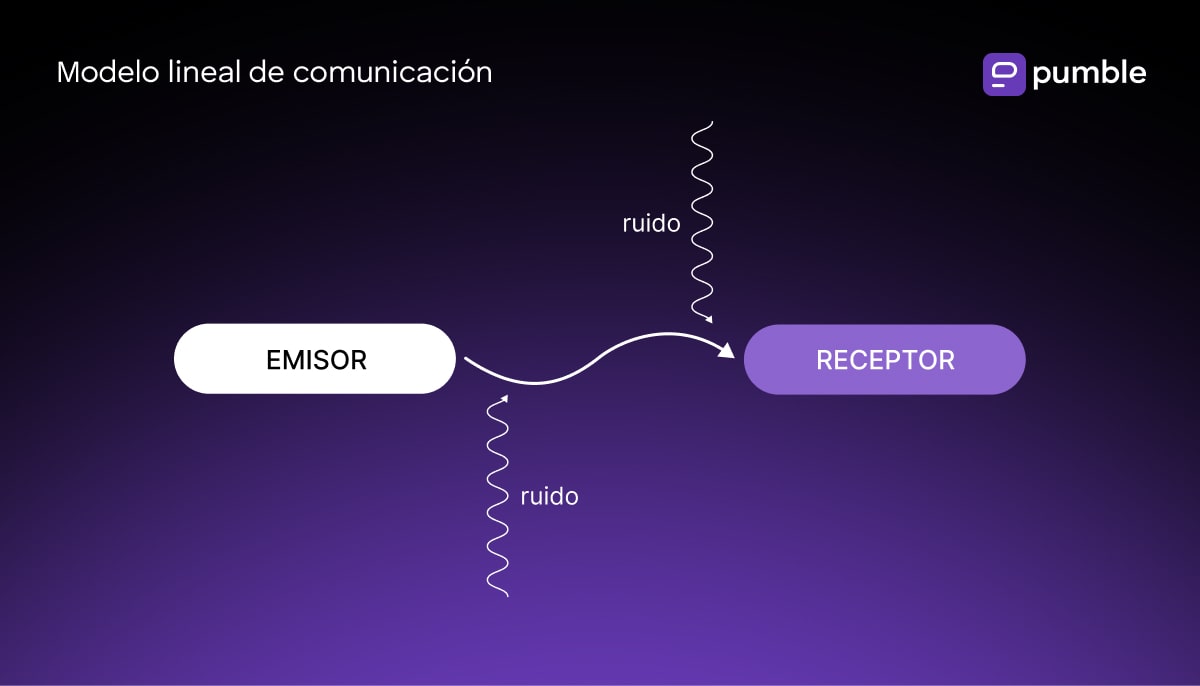
Canales son partes vitales de la comunicación: Explora los canales de Pumble
Los modelos lineales de comunicación más famosos incluyen:
- El modelo de comunicación de Lasswell,
- El modelo de comunicación de Aristóteles,
- El modelo de comunicación S-M-C-R de Berlo y
- El modelo de comunicación de Shannon-Weaver.
Los modelos lineales de comunicación son útiles para analizar la comunicación en marketing, ventas, relaciones públicas y otros procesos de comunicación unilaterales.
Sin embargo, cuando se requiere una perspectiva bidireccional los modelos transaccionales de comunicación resultan útiles.
Modelos de comunicación transaccional
En comparación con las teorías de la comunicación lineal, los modelos transaccionales describen el proceso de comunicación con mucho más detalle, incluyendo todos los matices que configuran tanto el proceso como el resultado de cualquier interacción.
Los modelos transaccionales de comunicación etiquetan a las partes involucradas no como emisor y receptor, sino como comunicadores. Esta importante distinción es fundamental para estos modelos porque, por definición:
El modelo de comunicación transaccional considera la comunicación como una transacción, donde los interlocutores crean el proceso comunicativo conjuntamente, influyendo tanto en su eficacia como en su resultado.
En otras palabras, la comunicación se considera un proceso dinámico donde los comunicadores crean un significado compartido al influir individualmente en el proceso comunicativo en tiempo real.
Los modelos de comunicación transaccional son particularmente útiles para analizar:
- Reuniones individuales,
- Comunicación ascendente,
- Comunicación descendente, o
- Cualquier otra situación de comunicación bidireccional.
A diferencia de los modelos de comunicación lineal, que pueden o no incluir el ruido como factor, todos los modelos de comunicación transaccional lo incluyen y comprenden su importancia y efectos en cualquier interacción.
Los modelos transaccionales también incluyen factores específicos como los contextos sociales, relacionales y culturales, que también desempeñan un papel fundamental en el proceso comunicativo.
Además, los modelos transaccionales muestran con precisión cómo las personas se comunican, crean conexiones e influyen mutuamente.
En resumen, estos tipos de modelos de comunicación describen mejor la naturaleza de la comunicación tal como ocurre en la vida real.
Los componentes principales de los modelos de comunicación transaccional incluyen:
- Comunicadores,
- Codificación,
- Decodificación,
- Mensaje,
- Canal, y
- Ruido.
Así es como se vería la comunicación visualmente, con el modelo transaccional aplicado:
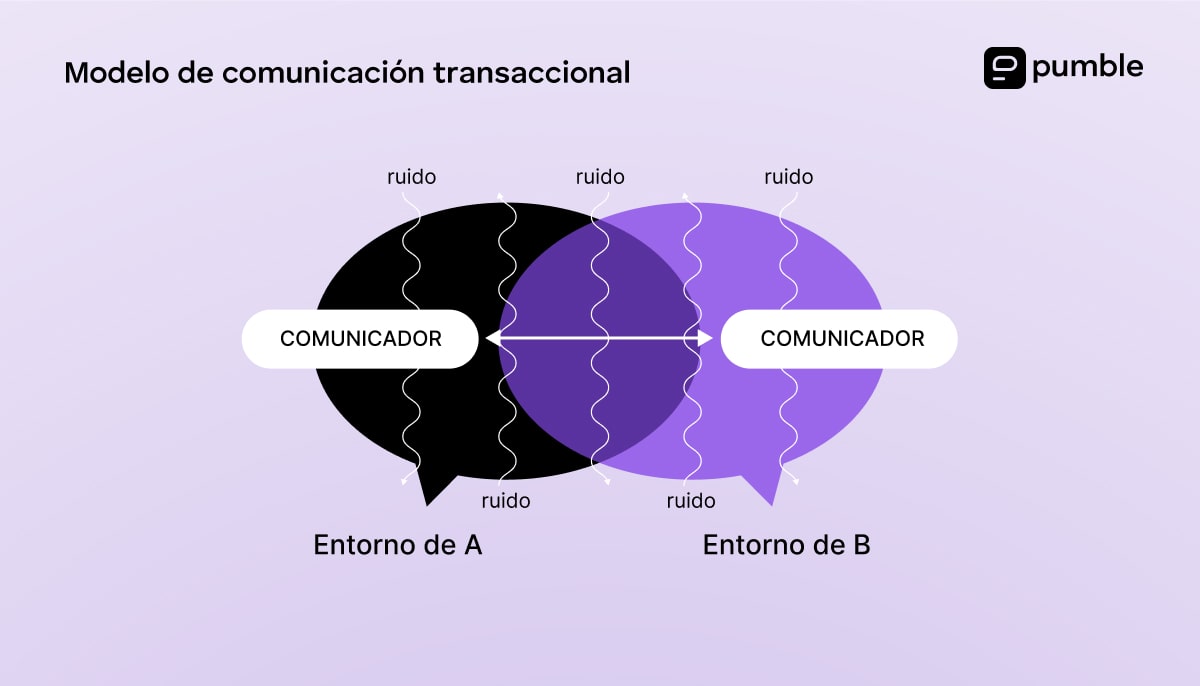
Como ya hemos mencionado, la mayoría de estos elementos también se incluyen en los modelos de comunicación lineal, siendo los comunicadores la principal diferencia.
Ahora, exploremos uno de los modelos de comunicación transaccional más completos, el modelo de Dean Barnlund, y veamos cómo esta perspectiva nos ayuda a comprenderlo mejor.
Modelo transaccional de comunicación de Dean Barnlund
El modelo de comunicación transaccional de Dean Barnlund se centra en la comunicación bidireccional, con el foco principal en el feedback inmediato, la forma en que la comunicación suele desarrollarse en la vida real, especialmente en un contexto presencial.
Este modelo de comunicación reconoce que la comunicación interpersonal es un proceso circular con un sistema de feedback de múltiples capas entre ambos.
Ambos comunicadores pueden afectar el mensaje que se envía e influir en el contexto del intercambio.
El emisor y el receptor intercambian sus roles, pero ambos son igualmente importantes. El feedback del emisor es, al mismo tiempo, la respuesta del receptor.
Tanto el emisor como el receptor son responsables del resultado al mismo tiempo, y la eficacia depende de ambos participantes, nunca de uno solo.
El diagrama del modelo de comunicación transaccional de Dean Barnlund incluye estos componentes:
- Codificación,
- Decodificación,
- Comunicadores,
- El mensaje (con las señales, el entorno y el ruido incluidos), y
- El canal.
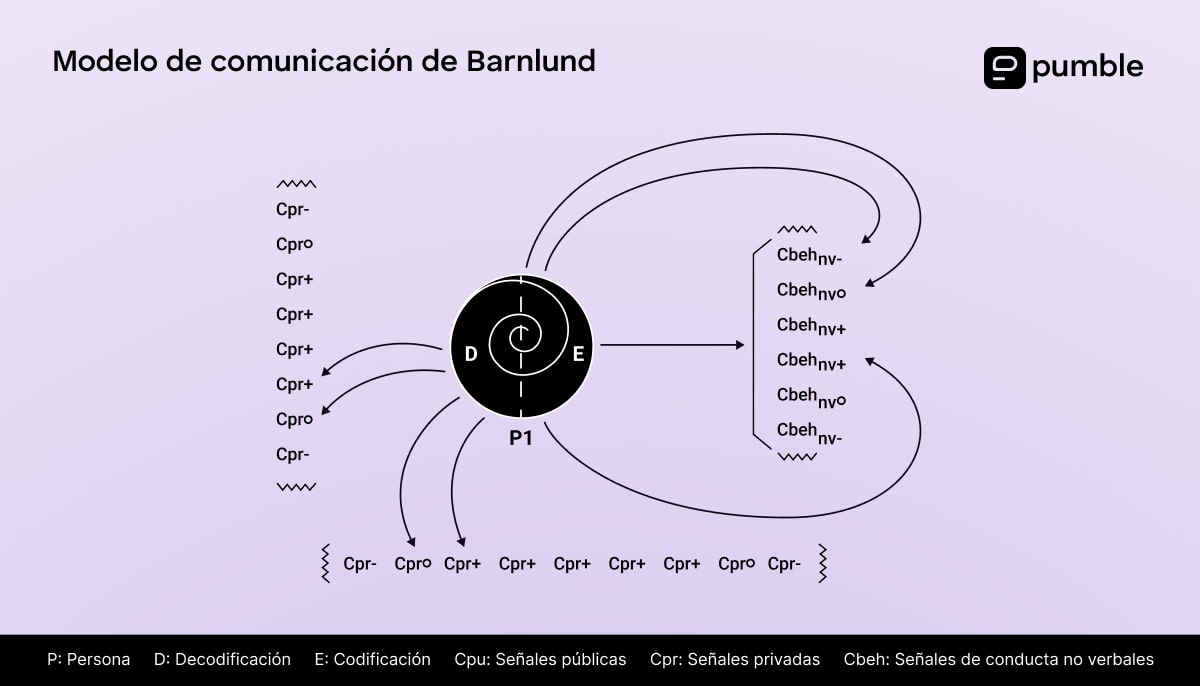
Aunque al principio pueda parecer intimidante, este modelo de comunicación enfatiza el papel de las señales que moldean nuestros mensajes. En otras palabras, considera la comunicación como un proceso dinámico y en constante cambio.
Como se muestra en el diagrama anterior, Dean Barnlund diferencia entre:
- Señales públicas (señales ambientales, entorno físico, entorno compartido, etc.) — etiquetadas como Cpu,
- Señales privadas (pensamientos personales del comunicador, antecedentes, sentimientos, recuerdos, etc.) — etiquetadas como Cpr, y
- Señales conductuales (comportamiento verbal y no verbal, como expresiones faciales, lenguaje corporal, postura, etc.) — etiquetadas como Cbeh.
Todas estas señales, así como el entorno y el ruido, forman parte del mensaje o lo influyen directamente. Y, a veces, al otro participante le resulta difícil distinguirlas.
La reacción de cada comunicador depende de sus antecedentes, experiencias, actitudes, creencias y su nivel de consciencia durante el intercambio.
El modelo de comunicación transaccional de Barnlund funciona mejor cuando se aplica a:
- Interacciones cara a cara entre dos o más participantes,
- Situaciones de comunicación formal o informal en el trabajo,
- Llamadas de voz,
- Diversos tipos de reuniones, etc.
Ahora, analicemos los elementos del modelo transaccional de comunicación y exploremos ejemplos específicos.
Elementos y ejemplos de la comunicación transaccional
Al analizar la comunicación y los posibles obstáculos, es importante tener en cuenta la mayor cantidad de elementos posible para lograr una comunicación eficaz en un entorno profesional.
El modelo de comunicación transaccional logra esto mediante la inclusión de:
- Feedback,
- Ruido,
- Contexto,
- Señales no verbales,
- Escucha activa, y
- Continuidad.
Naturalmente, todos estos elementos se superponen en tiempo real entre dos o más comunicadores. Analicemos con más detalle cómo sucede esto.
1. Feedback
En el contexto de la comunicación transaccional, el feedback incluye la influencia, tanto verbal como tácita, entre dos o más comunicadores. El feedback es inmediato y modifica sutilmente toda la comunicación a lo largo de su duración.
El feedback puede incluir desde una respuesta verbal en un intercambio cara a cara hasta una reacción con un emoji o un gesto como un guiño o un asentimiento.
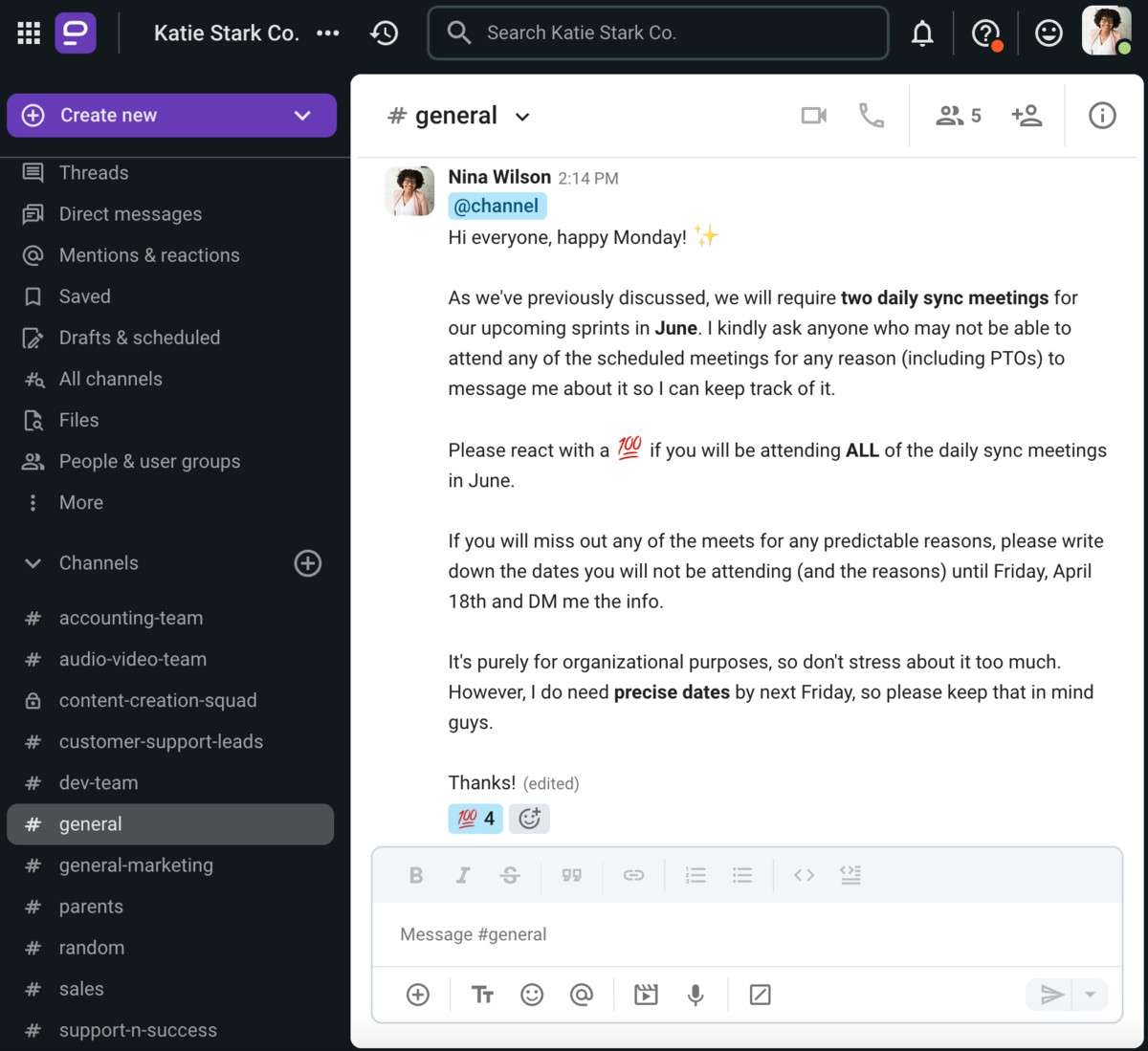
El inmenso valor del feedback reside tanto en su capacidad para unir a las personas como en su potencial para generar intercambios y acuerdos significativos durante la comunicación.
Al contrario de lo que algunos podrían pensar, la falta de feedback a menudo no contribuye a la “paz general”. Dependiendo del temperamento y el carácter de uno o más comunicadores, la falta de feedback podría considerarse engañosa o incluso manipuladora.
Esto sucede porque, sin suficiente feedback, cualquier información poco clara o faltante probablemente se llene de ruido o suposiciones, lo cual es la receta perfecta para la mala comunicación.
🎓 Consejo Pro de Pumble
Aunque el feedback en la comunicación y el feedback en el trabajo puedan parecer iguales, son dos cosas completamente diferentes. Para más información sobre el feedback en el entorno empresarial, consulta la sección de nuestro blog:
Proporciona y solicita feedback de forma rápida y sencilla a través de Pumble
2. Ruido
El ruido es otro elemento importante que se tiene en cuenta en los modelos de comunicación transaccional.
En un caso ideal, todas las distracciones físicas, el estrés y los malentendidos se gestionan simultáneamente, a menudo en tiempo real, lo que garantiza que se alcance el objetivo de la conversación.
Por supuesto, esto no siempre es así. Y en situaciones menos ideales es cuando surgen conflictos y malentendidos.
El ruido abarca un amplio espectro de posibles interrupciones o diferencias, y representa cualquier interferencia o distracción en el lugar de trabajo que pueda dificultar la comunicación. Estos obstáculos en la comunicación se deben a la falta de un feedback claro o a un desajuste contextual.
Los tipos de ruido en la comunicación incluyen:
- Ruido físico. Se refiere a cualquier estímulo externo o ambiental que puede distraer, como: obras de construcción ruidosas, ruido de multitud en una cafetería o incluso mala caligrafía (en la comunicación escrita).
- Ruido fisiológico. Este tipo de ruido se refiere a factores biológicos como: murmurar o hablar demasiado rápido, un acento o dialecto difícil de entender, o sentirse mal de una manera que afecta la concentración.
- Ruido psicológico. Se relaciona con prejuicios o sesgos, mentalidad cerrada o negativa a considerar una perspectiva diferente, o estados emocionales que influyen en la recepción de un mensaje (ira, tristeza, emoción, etc.).
- Ruido semántico. Algunos ejemplos incluyen: usar terminología compleja con una persona que no está familiarizada con el contexto o el significado, oraciones ambiguas o mal construidas, usar un chiste interno o jerga desconocida.
Aunque el ruido puede ser un obstáculo difícil, mantener la concentración en el objetivo principal del intercambio es fundamental para una comunicación exitosa.
Dicho esto, veamos cómo el contexto influye en nuestra comprensión del mensaje.
Limita las distracciones en el lugar de trabajo y mejora tu comunicación con Pumble
3. Contexto
El modelo transaccional de comunicación, basado directamente en el feedback y el ruido, también considera:
- Contexto social,
- Contexto físico, y
- Contexto cultural.
Todas estas circunstancias influyen en cómo percibimos el mensaje.
Por ejemplo, el comportamiento de un comunicador probablemente será diferente en un entorno formal, que en uno menos formal. Además, la presencia de una persona importante o notoriamente “difícil” en una sala también podría afectar considerablemente el proceso de comunicación de una o varias personas.
Todos estos ejemplos pueden incluir influencias psicológicas o físicas que pueden alterar sustancialmente la interacción, y todas ellas conforman el contexto más amplio (que combina los tres subtipos).
Por supuesto, estas influencias pueden afectar no solo a una interacción, sino también a varias interacciones diferentes. Múltiples encuentros a menudo influyen en la postura de las personas involucradas, la forma en que cada interlocutor presenta su feedback y su nivel de cooperación a nivel individual o grupal.
Analizar la comunicación desde una perspectiva transaccional implica evaluar las vastas influencias que la modifican en tiempo real, ya sea de forma sutil o menos sutil.
En caso de conflicto, la persona a cargo de la comunicación debe ser capaz de considerar todas las variables posibles para mejorar las interacciones futuras.
Veamos un ejemplo.
Jason tiene problemas para acceder a un sitio web importante para su trabajo. Con la reputación de necesitar varios recordatorios antes de asimilar algo, sus compañeros tardan en responder, probablemente debido a la frustración con sus frecuentes preguntas. Su jefa, Yasmeen, interviene y soluciona el problema abordando simultáneamente la falta de respuesta del equipo y el olvido de Jason, equilibrando así la situación.
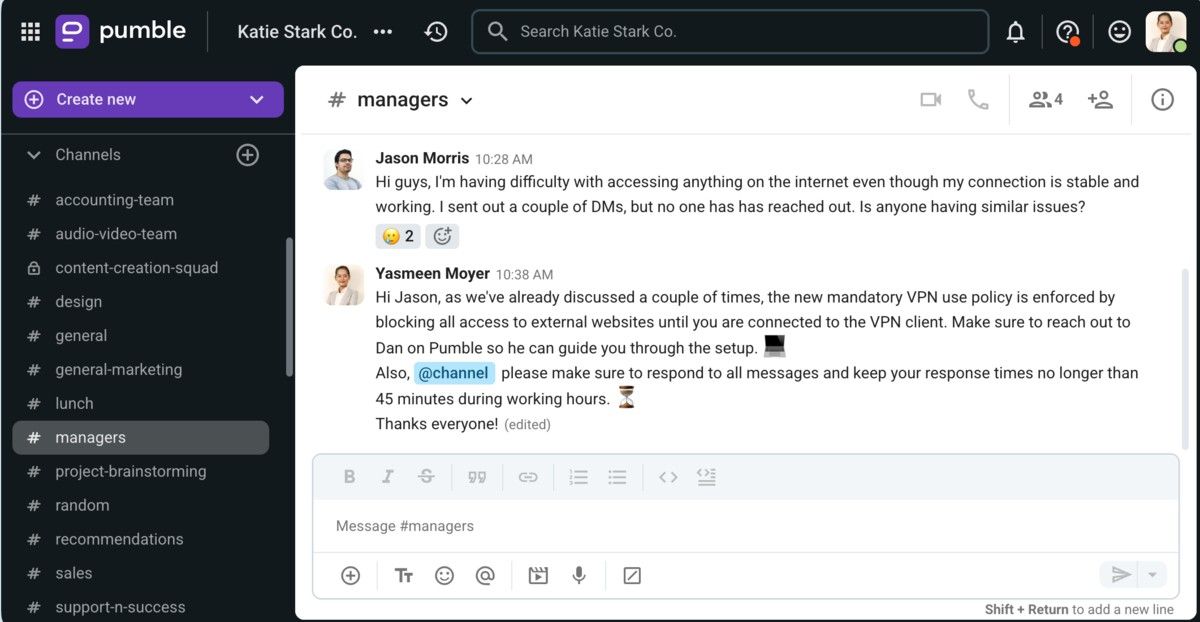
Simplifica la comunicación del equipo con Pumble
4. Señales no verbales
Las señales no verbales son uno de los elementos que quizás no percibamos a simple vista, pero que pueden afectar profundamente tanto las conversaciones presenciales como las videoconferencias.
El contacto visual, el lenguaje corporal y el tono de voz son elementos no verbales cruciales que moldean la sensación y el flujo de una conversación, e incluso influyen significativamente en su resultado, especialmente cuando la persuasión es fundamental.
Por ejemplo, evitar el contacto visual a menudo se percibe como engañoso, mientras que una postura abierta y un contacto visual seguro generalmente se perciben como genuinos y confiables.
5. Escucha activa
En el contexto de la comunicación transaccional, la escucha activa es un componente clave, ya que está directamente relacionada con el proceso, tal como lo describe el modelo.
Esta habilidad comunicativa implica anticipar las diferentes señales, tanto propias como del interlocutor, para alcanzar un resultado mutuamente deseado.
La escucha activa implica:
- Participar en una conversación,
- Recordar detalles importantes,
- Abordar la esencia del problema o de varios problemas en cuestión, y
- Abstenerse de juzgar.
Requiere un conjunto de diferentes habilidades conversacionales, como la paralingüística, la conciencia de uno mismo, la conciencia social, la empatía, el pensamiento crítico, la retención de memoria y muchas más.
En el contexto de los modelos de comunicación transaccional, podemos afirmar con seguridad que la escucha activa es la aplicación práctica de todos los conceptos descritos en este modelo.
El amplio conjunto de habilidades que componen la escucha activa es algo que debe trabajarse y perfeccionarse constantemente, pero tener presente este concepto general y aplicarlo con diligencia sin duda te convertirá en un comunicador mucho mejor tanto en conversaciones informales como formales.
🎓 Consejo Pro de Pumble
¿Quieres profundizar en tu comprensión de la escucha activa? Asegúrate de darle una oportunidad a la “escucha profunda”. Lee sobre esto en nuestra entrada del blog:
6. Continuidad
La comunicación transaccional considera el seguimiento, los ciclos de feedback y las conversaciones continuas. Las relaciones a largo plazo y la confianza a menudo surgen de múltiples encuentros, en lugar de una sola interacción, algo que reconoce este modelo.
La continuidad enfatiza que la comunicación es un proceso que no solo incluye los elementos mencionados, sino que también genera nuevos contextos, relaciones y significados.
A diferencia de los modelos lineales, donde la información se transmite de una fuente a otra, el modelo de comunicación transaccional subraya que la comunicación nos ayuda a construir nuevas realidades, crear vínculos, moldear conceptos, crear alianzas e influir tanto entre nosotros como en el mundo que nos rodea.
Esto es lo que significa ser "emisor y receptor" al mismo tiempo que comunicador: cada conversación es una vía de doble sentido en la que la suma de muchas partes discretas forma una totalidad mayor y más significativa.
Construye relaciones con tus compañeros de trabajo a través de Pumble
Beneficios del modelo transaccional para una comunicación eficaz
En este contexto, adoptar modelos de comunicación transaccional implica adaptar tu comprensión de la comunicación y aplicar este modelo a tus circunstancias para mejorarla.
¿Por qué querrías hacer algo así? A continuación te explicamos por qué.
Beneficio 1: La comunicación se ve desde una perspectiva real
Si tienes dudas sobre la comunicación en tu equipo inmediato, el enfoque transaccional para el análisis de la comunicación es la solución.
Con este modelo, podrás detectar rápidamente los cuellos de botella en el proceso de comunicación en la mayoría de las interacciones que presencies.
¿Alguien pasa por alto una señal de comunicación obvia? ¿Alguien no proporciona feedback constructivo inmediato durante una conversación? Podrás detectar rápidamente todos estos obstáculos a través de la perspectiva transaccional.
Beneficio 2: El enfoque transaccional fortalece a tu equipo
Dado que este modelo enfatiza la respuesta inmediata y el contexto, podrás identificar el fondo de cualquier problema de comunicación.
¿El ruido está afectando demasiado la interacción? Quizás haya cosas que se asumen o se ocultan deliberadamente y que deberían decirse abiertamente. Promover esto inspira feedback inmediato, que es el primer paso hacia un feedback constructivo en todo el equipo.
Un mejor feedback en tu equipo acortará, simplificará y mejorará el proceso de comunicación. Con un proceso de comunicación mejorado, la cooperación se vuelve mucho más fácil. Con una cooperación simplificada, el trabajo se realiza con mayor eficacia.
La suma de todas estas partes discretas: un equipo mucho más fuerte.
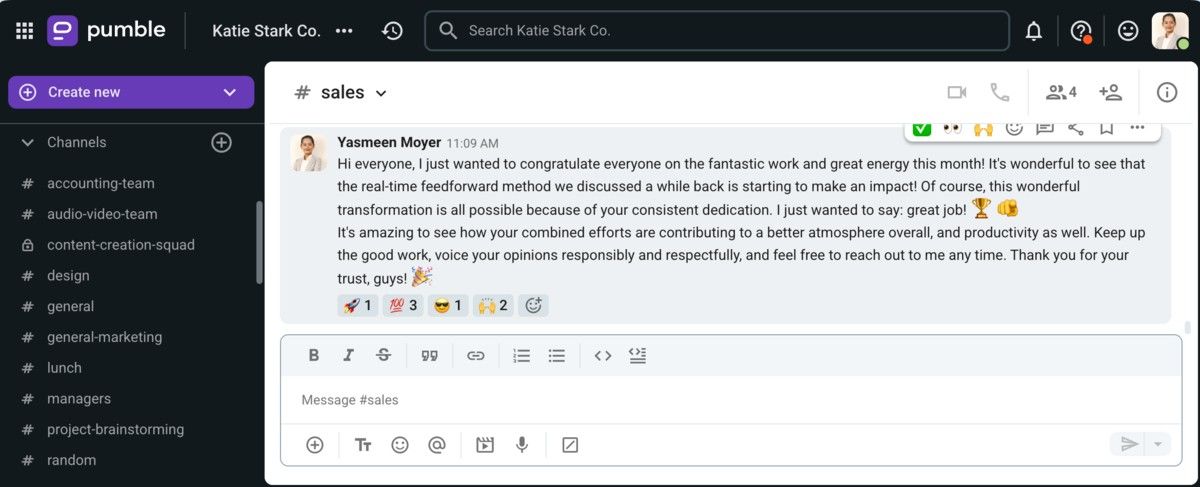
Mejora la colaboración en equipo con Pumble
Beneficio 3: Los malentendidos se resuelven con mayor facilidad
Con el modelo de comunicación transaccional, se mitigan los errores de comunicación, lo que facilita la resolución de conflictos en los equipos.
Imagina que todos en tu equipo inmediato conocen el modelo transaccional de comunicación y su enfoque. ¿Cómo se comunicaría una persona con conocimiento de diversos tipos de contexto, ruido, feedback y señales verbales o no verbales, en comparación con alguien que no está familiarizado con ninguno de estos conceptos?
Con la motivación adecuada, podría ser increíblemente diferente.
Además, ya que el enfoque transaccional de la comunicación fomenta el feedback inmediato, la consciencia y la empatía, este modelo fomenta una dinámica de equipo eficaz y reduce la probabilidad de conflictos catastróficos y problemas de comunicación.
🎓 Consejo Pro de Pumble
Para obtener ideas sobre cómo resolver conflictos de la forma más elegante posible, no olvides consultar:
Resuelve conflictos en tu equipo rápidamente a través de Pumble
Fomenta la comunicación transaccional con Pumble
Para fomentar un enfoque transaccional en la comunicación, lo mejor es adquirir una herramienta integral que te permita evaluar la comunicación desde diferentes perspectivas.
Aquí es donde entra Pumble.
Pumble es una herramienta de comunicación integral para profesionales, diseñada para simplificar los procesos de comunicación e impulsar la colaboración y la productividad.
Con el enfoque adecuado, se puede fomentar la comunicación transaccional mediante las siguientes funciones de Pumble:
- Videoconferencias: para realizar un seguimiento más sencillo de los participantes y sus señales,
- Grabación de reuniones: para revisar las reuniones y evaluar posibles problemas de comunicación,
- Canales privados y públicos: para reducir el ruido notificando a todas las personas relevantes simultáneamente,
- Búsqueda: para navegar rápidamente por las conversaciones y encontrar información o archivos compartidos sin tener que preguntar repetidamente.
Estas y muchas otras funciones, combinadas con la estrategia y la mentalidad adecuadas, garantizan una transformación de la comunicación en tu lugar de trabajo.
¡Prepárate para convertir a tu equipo en una fuerza motriz! ¡Prueba Pumble de CAKE.com hoy mismo!
Cómo revisamos esta publicación: Nuestros escritores y editores monitorean las publicaciones y las actualizan cuando hay nueva información disponible, para mantenerlas frescas y relevantes.
